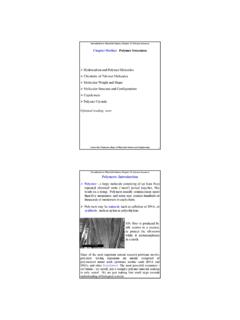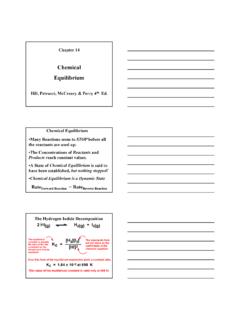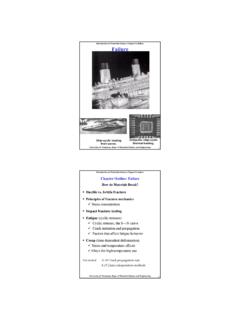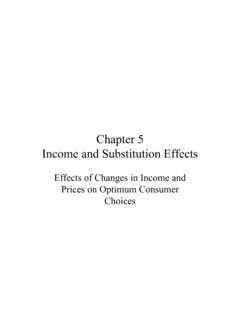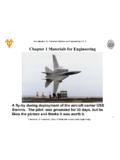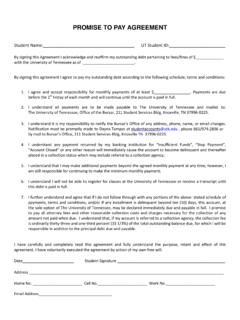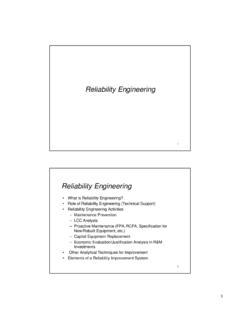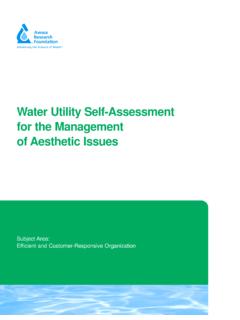Transcription of Chapter 4 Defects - University of Tennessee
1 1 Introduction To Materials Science, Chapter 4, Imperfections in solidsUniversity of Tennessee , Dept. of Materials Science and Engineering1 Crystals are like people, it is the Defects in them which tend to make them interesting! - Colin Humphreys. Defects in Solids 0D, Point defects9vacancies9interstitials9impuriti es, weight and atomic composition 1D, Dislocations9edge9screw 2D, Grain boundaries9tilt9twist 3D, Bulk or Volume Defects Atomic - Microscopy & Grain size determination Not Covered / Not TestedChapter OutlineIntroduction To Materials Science, Chapter 4, Imperfections in solidsUniversity of Tennessee , Dept.
2 Of Materials Science and Engineering2 Real crystals are never perfect, there are always defectsSchematic drawing of a poly-crystal with many Defects by Helmut F ll, University of Kiel, Germany. Defects Introduction (I)2 Introduction To Materials Science, Chapter 4, Imperfections in solidsUniversity of Tennessee , Dept. of Materials Science and Engineering3 Defects Introduction (II) Defects have a profound impact on the macroscopic properties of materialsBonding+ Structure+ DefectsPropertiesIntroduction To Materials Science, Chapter 4, Imperfections in solidsUniversity of Tennessee , Dept. of Materials Science and Engineering4 CompositionBondingCrystal StructureThermomechanicalProcessingMicro structureDefects Introduction (III)The processing determines the defectsdefects introduction and manipulation3 Introduction To Materials Science, Chapter 4, Imperfections in solidsUniversity of Tennessee , Dept.
3 Of Materials Science and Engineering5 Types of DefectsDefects may be classified into four categories depending on their dimension: 0D, Point Defects : atoms missing or in irregular places in the lattice (vacancies, interstitials, impurities) 1D, Linear Defects : groups of atoms in irregular positions ( screw and edge dislocations) 2D,Planar Defects : the interfaces between homogeneous regions of the material (grain boundaries, external surfaces) 3D, Volume Defects : extended Defects (pores, cracks)Introduction To Materials Science, Chapter 4, Imperfections in solidsUniversity of Tennessee , Dept.
4 Of Materials Science and Engineering6 Point Defects : vacancies & self-interstitialsSelf-interstitialsVaca ncyVacancy- a lattice position that is vacant because the atom is - an atom that occupies a place outside the normal lattice position. It may be the same type of atom as the others (self interstitial) or an impurity interstitial To Materials Science, Chapter 4, Imperfections in solidsUniversity of Tennessee , Dept. of Materials Science and Engineering7 The equilibrium number of vacancies formed as a result of thermal vibrations may be calculated from thermodynamics:How many vacancies are there?
5 Where Nsis the number of regular lattice sites, kBis theBoltzmann constant, Qvis the energy needed to form a vacant lattice site in a perfect crystal, and T the temperature in Kelvin (note, not inoCoroF).Using this equation we can estimate that at room temperature in copper there is one vacancy per 1015lattice atoms, whereas at high temperature, just below the melting point there is one vacancy for every 10,000 , that the above equation gives the lower end estimation of the number of vacancies, a large numbers of additional (non-equilibrium) vacancies can be introduced in a growth process or as a result of further treatment (plastic deformation, quenchingfrom high temperature to the ambient one, etc.)
6 =TkQexpNNBvsvIntroduction To Materials Science, Chapter 4, Imperfections in solidsUniversity of Tennessee , Dept. of Materials Science and Engineering8 Let s estimate the number of vacancies in Cu at room TThe Boltzmann s constant kB= 10-23 J/atom-K = 10-5eV/atom-KThe temperature in Kelvin T= 27oC + 273 = 300 K. kBT = 300 K 10-5eV/K = eVThe energy for vacancy formation Qv= eV/atomThe number of regular lattice sites Ns= NA /AcuNA= 1023atoms/mol = g/cm3 Acu= g/mol =TkQexpNNBvsv() = == = =5 Introduction To Materials Science, Chapter 4, Imperfections in solidsUniversity of Tennessee , Dept.
7 Of Materials Science and Engineering9 OBSERVING EQUIL. VACANCY CONC. Low energy electron microscope view of a (110) surface of NiAl. Increasing T causes surface island ofatoms to grow. Why?The equil. vacancy conc. increases via atom motion from the crystalto the surface, where they join the with permission from Nature( McCarty, Nobel, and Bartelt, "Vacancies inSolids and the Stability of Surface Morphology",Nature, Vol. 412, pp. 622-625 (2001). Image m by m.) Copyright (2001) Macmillan Publishers, To Materials Science, Chapter 4, Imperfections in solidsUniversity of Tennessee , Dept.
8 Of Materials Science and Engineering10 Self-interstitials in metals introduce large distortions in the surrounding lattice the energy of self-interstitial formation is ~ 3 times larger as compared to vacancies (Qi~ 3 Qv) equilibrium concentration of self-interstitials is very low (less than one self-interstitial per cm3at room T).Self-interstitials12345 Other point Defects : self-interstitials, impuritiesSchematic representation of different point Defects :(1) vacancy;(2) self-interstitial;(3) interstitial impurity;(4,5) substitutional impuritiesThe arrows show the local stresses introduced by the point To Materials Science, Chapter 4, Imperfections in solidsUniversity of Tennessee , Dept.
9 Of Materials Science and Engineering11 ImpuritiesImpurities - atoms which are different from the host All real solids are impure. Very pure metals - one impurity per 106atoms May be intentional or unintentionalExamples: carbon added in small amounts to iron makes steel, which is stronger than pure iron. Boron added to silicon change its electrical properties. Alloys- deliberate mixtures of metalsExample: sterling silver is silver copper alloy. Stronger than pure To Materials Science, Chapter 4, Imperfections in solidsUniversity of Tennessee , Dept. of Materials Science and Engineering12 Solid SolutionsSolid solutionsare made of a host (the solventor matrix) which dissolves the minor component (solute).
10 The ability to dissolve is called solubility. Solvent: in an alloy, the element or compound present in greater amount Solute: in an alloy, the element or compound present in lesser amount Solid Solution: 9homogeneous 9maintain crystal structure 9contain randomly dispersed impurities (substitutional or interstitial) Second Phase: as solute atoms are added, new compounds / structures are formed, or solute forms local precipitates(discussed in Chapter 9)Whether the addition of impurities results in formation of solid solution or second phase depends the nature of the impurities, their concentration and temperature, To Materials Science, Chapter 4, Imperfections in solidsUniversity of Tennessee , Dept.
